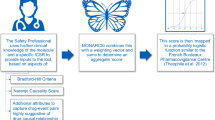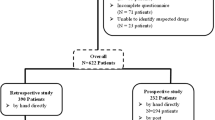Abstract
In pharmacovigilance, reported cases are considered suspected adverse drug reactions (ADR). Health authorities have thus adopted structured causality assessment methods, allowing the evaluation of the likelihood that a medicine was the causal agent of an adverse reaction. The aim of this work was to develop and validate a new causality assessment support system used in a regional pharmacovigilance centre. A Bayesian network was developed, for which the structure was defined by an expert, aiming at implementing the current guidelines for causality assessment, while the parameters were learnt from 593 completely-filled ADR reports evaluated by the Portuguese Northern Pharmacovigilance Centre expert between 2000 and 2012. Precision, recall and time to causality assessment (TTA) was evaluated, according to the WHO causality assessment guidelines, in a retrospective cohort of 466 reports (April to September 2014) and a prospective cohort of 1041 reports (January to December 2015). Results show that the network was able to easily identify the higher levels of causality (recall above 80%), although strugling to assess reports with a lower level of causality. Nonetheless, the median (Q1:Q3) TTA was 4 (2:8) days using the network and 8 (5:14) days using global introspection, meaning the network allowed a faster time to assessment, which has a procedural deadline of 30 days, improving daily activities in the centre.
Access this chapter
Tax calculation will be finalised at checkout
Purchases are for personal use only
Similar content being viewed by others

References
Agbabiaka, T.B., Savović, J., Ernst, E.: Methods for causality assessment of adverse drug reactions: a systematic review. Drug Saf. 31(1), 21–37 (2008). http://www.ncbi.nlm.nih.gov/pubmed/18095744
Arimone, Y., Bégaud, B., Miremont-Salamé, G., Fourrier-Réglat, A., Moore, N., Molimard, M., Haramburu, F.: Agreement of expert judgment in causality assessment of adverse drug reactions. Eur. J. Clin. Pharmacol. 61, 169–173 (2005)
Arimone, Y., Miremont-Salamé, G., Haramburu, F., Molimard, M., Moore, N., Fourrier-Réglat, A., Bégaud, B.: Inter-expert agreement of seven criteria in causality assessment of adverse drug reactions. Br. J. Clin. Pharmacol. 64(4), 482–488 (2007). http://www.pubmedcentral.nih.gov/articlerender.fcgi?artid=2048553&tool=pmcentrez&rendertype=abstract
Darwiche, A.: Modeling and Reasoning with Bayesian Networks. Cambridge University Press, Cambridge (2009). http://www.amazon.com/Modeling-Reasoning-Bayesian-Networks-Darwiche/dp/0521884381
Darwiche, A.: Bayesian networks. Commun. ACM 53(12), 80–90 (2010). http://portal.acm.org/citation.cfm?doid=1859204.1859227
Højsgaard, S.: Graphical independence networks with the gRain package for R. J. Stat. Softw. 46(10), 1–26 (2012). http://www.jstatsoft.org/v46/i10/paper
INFARMED: Farmacovigilância em Portugal. Technical report (2004)
Jones, J.: Adverse drug reactions in the community health setting: approaches to recognizing, counseling, and reporting. Fam. Community Health 5(2), 58–67 (1982). http://www.ncbi.nlm.nih.gov/pubmed/10278126
Karch, F.E., Lasagna, L.: Toward the operational identification of adverse drug reactions. Clin. Pharmacol. Ther. 21(3), 247–254 (1977). http://www.ncbi.nlm.nih.gov/pubmed/837643
Latoszek-Berendsen, A., Tange, H., van den Herik, H.J., Hasman, A.: From clinical practice guidelines to computer-interpretable guidelines. A literature overview. Methods Inf. Med. 49(6), 550–570 (2010). http://www.ncbi.nlm.nih.gov/pubmed/21085744
Lauritzen, S.L., Spiegelhalter, D.J.: Local computations with probabilities on graphical structures and their application to expert systems. J. R. Stat. Soc. Ser. B 50(2), 157–224 (1988). http://wrap.warwick.ac.uk/24233/
Lindquist, M., Staahl, M., Bate, A., Edwards, I.R., Meyboom, R.H.: A retrospective evaluation of a data mining approach to aid finding new adverse drug reaction signals in the WHO international database. Drug Saf. 23(6), 533–542 (2000)
Lucas, P.: Bayesian analysis, pattern analysis, and data mining in health care. Current Opin. Crit. Care 10(5), 399–403 (2004). http://www.ncbi.nlm.nih.gov/pubmed/15385759
Lucas, P.J.F., van der Gaag, L.C., Abu-Hanna, A.: Bayesian networks in biomedicine and health-care. Artif. Intell. Med. 30(3), 201–214 (2004). http://www.ncbi.nlm.nih.gov/pubmed/15081072
Miremont, G., Haramburu, F., Bégaud, B., Péré, J.C., Dangoumau, J.: Adverse drug reactions: physicians’ opinions versus a causality assessment method. Eur. J. Clin. Pharmacol. 46, 285–289 (1994)
Naranjo, C.A., Busto, U., Sellers, E.M., Sandor, P., Ruiz, I., Roberts, E.A., Janecek, E., Domecq, C., Greenblatt, D.J.: A method for estimating the probability of adverse drug reactions. Clin. Pharmacol. Ther. 30, 239–245 (1981)
R Core Team: R: A Language and environment for statistical computing (2015). http://www.r-project.org/
Robin, X., Turck, N., Hainard, A., Tiberti, N., Lisacek, F., Sanchez, J.C., Müller, M.: pROC: an open-source package for R and S+ to analyze and compare ROC curves. BMC Bioinf. 12, 77 (2011)
Scutari, M.: Learning Bayesian networks with the bnlearn R Package. J. Stat. Softw. 35, 22 (2010). http://arXiv.org/abs/0908.3817
World Health Organization. Uppsala Monitoring Centre (2017). http://www.who-umc.org/
Acknowledgements
This work has been developed under the scope of project NanoSTIMA [NORTE-01-0145-FEDER-000016], which was financed by the North Portugal Regional Operational Programme [NORTE 2020], under the PORTUGAL 2020 Partnership Agreement, and through the European Regional Development Fund [ERDF].
Author information
Authors and Affiliations
Corresponding author
Editor information
Editors and Affiliations
Rights and permissions
Copyright information
© 2017 Springer International Publishing AG
About this paper
Cite this paper
Rodrigues, P.P., Ferreira-Santos, D., Silva, A., Polónia, J., Ribeiro-Vaz, I. (2017). Implementing Guidelines for Causality Assessment of Adverse Drug Reaction Reports: A Bayesian Network Approach. In: ten Teije, A., Popow, C., Holmes, J., Sacchi, L. (eds) Artificial Intelligence in Medicine. AIME 2017. Lecture Notes in Computer Science(), vol 10259. Springer, Cham. https://doi.org/10.1007/978-3-319-59758-4_6
Download citation
DOI: https://doi.org/10.1007/978-3-319-59758-4_6
Published:
Publisher Name: Springer, Cham
Print ISBN: 978-3-319-59757-7
Online ISBN: 978-3-319-59758-4
eBook Packages: Computer ScienceComputer Science (R0)



